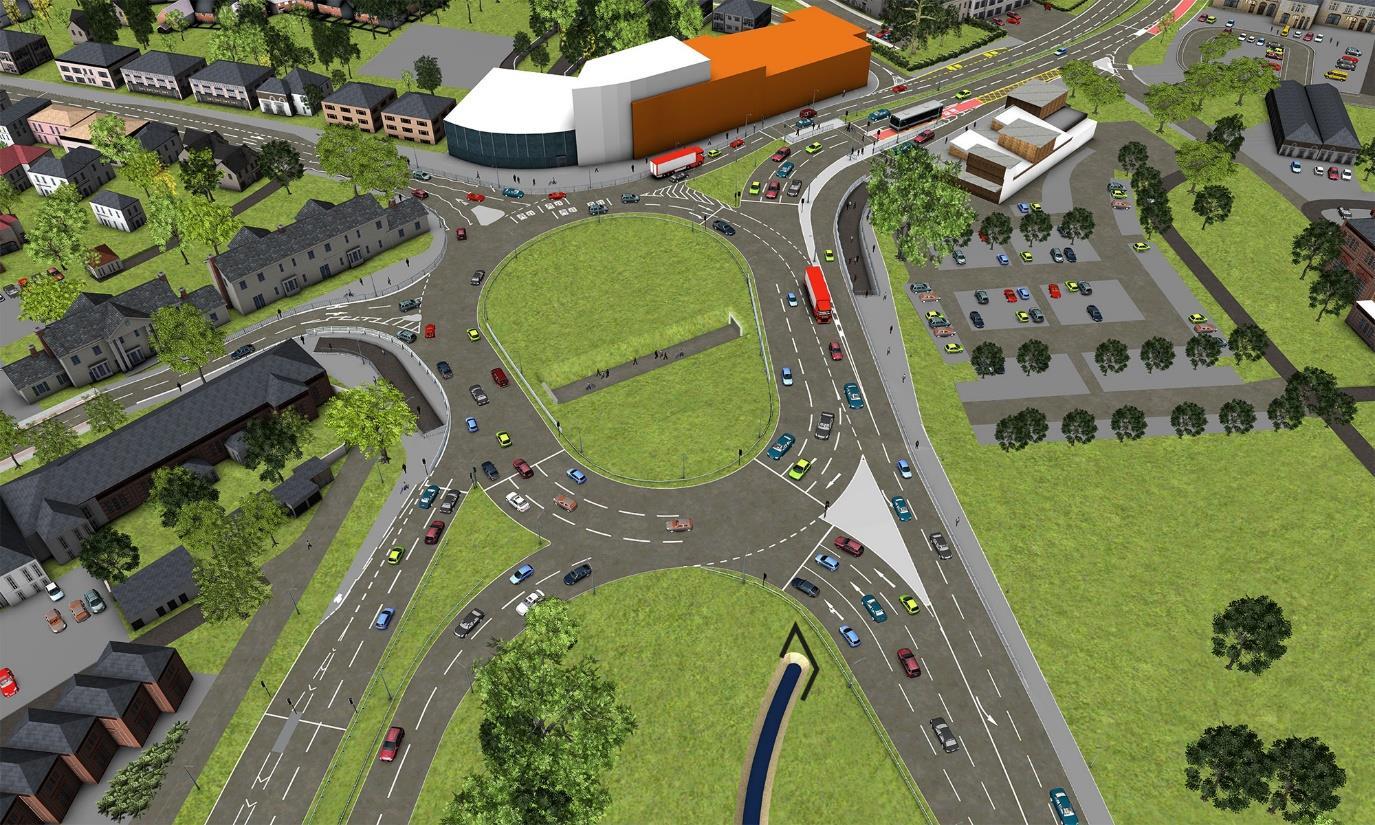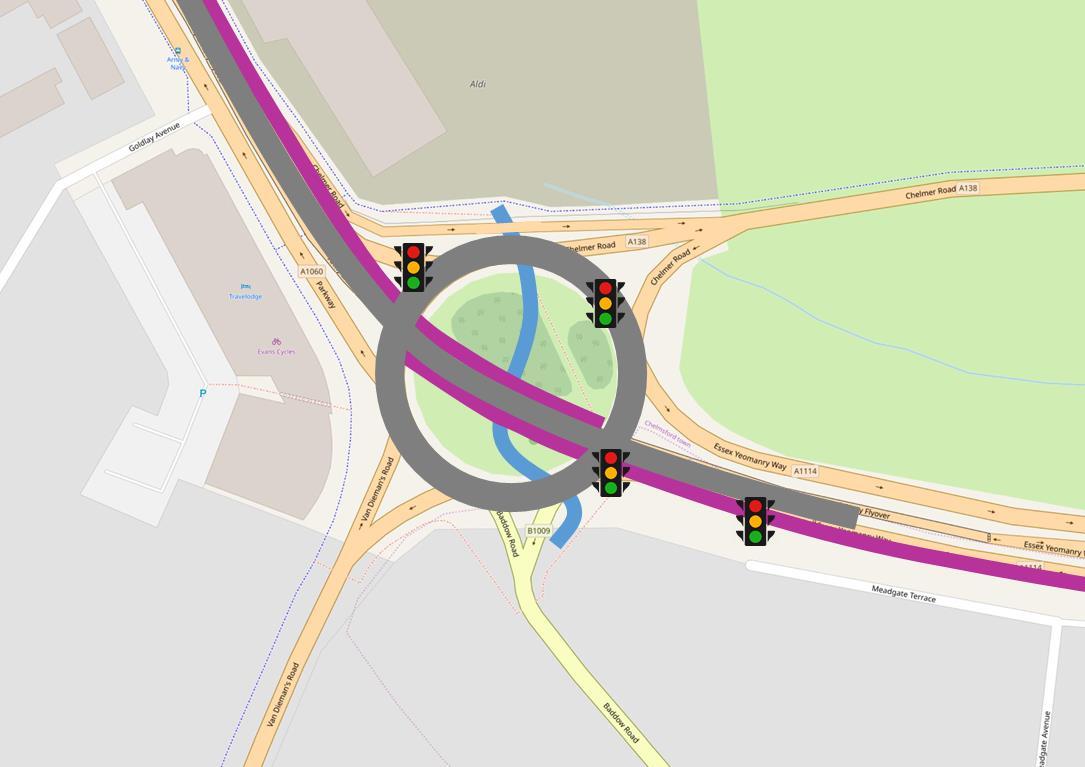
14 minute read
Army & Navy: STAGE 2
Briefing Note
This update was sent to partners in April 2020 to update them on the project in place of planned workshops which had to be cancelled due to the COVID-19 outbreak
Advertisement
Sign up for the Army and Navy e-newsletter at:
www.essex.gov.uk/armyandnavy
1. Background and Objectives Army and Navy
The Army and Navy Junction
The junction is significantly over capacity during peak times, meaning drivers regularly experience delays and it has very little resilience to cope with traffic incidents
The issues have been compounded by the closure of the flyover on safety grounds. The structure has now been removed and work is ongoing to develop the right long-term solution at the junction
About 70,000 vehicles a day use the Army and Navy junction following the Flyover closure
The wider Chelmsford road network is operating at 96% capacity at peak times, resulting in poor resilience to incidents and poor journey time reliability
There is a lack of space to create further capacity for general traffic, so we must also look at how we can encourage more people to think differently about how they travel, particularly for shorter journeys which are currently made by car and provide the infrastructure for them to do so
A significant number of journeys to work in Chelmsford are made by private vehicle but are less than 5km in length
There is an Air Quality Management Area at the junction and emerging air quality issues on Parkway near the Odeon roundabout If everyone in Chelmsford were to switch just two of their journeys to work (including to the train station) each week to sustainable modes, this would remove 165,000 trips from the network
Objectives
The following objectives for the project were agreed by the Army and Navy Task Force and are being used to assist in assessing and prioritising the emerging options.
• Provide enhanced connectivity for communities within and beyond Chelmsford to support and promote sustainable housing, economic growth and regeneration both now and in the future
• Offer inclusive, attractive, and safe active travel measures (walking and cycling) across an improved and comprehensive network to encourage increased use
• Improve safety and the perception of safety for all users on the Chelmsford City network to enhance and promote a safe travelling environment
• Positively manage resilience and journey time reliability improving journey times for passenger transport services travelling into/out of the City Centre Core
• Actively manage resilience and journey time reliability for private transport trips within the core urban area of Chelmsford and, in particular, management of through-trips
• Manage environmental conditions (Air Quality and Noise)
• Where possible, increase the attractiveness of the gateway into the City Centre through design and public realm enhancements
Chelmsford Future Transport Network Strategy
The vision for Chelmsford to 2036:
“For Chelmsford's transport system to become 'best in class’, rivalling similar cities across the UK, offering enhanced connectivity and access to opportunities for residents, visitors and businesses to support the sustainable economic growth of the city.”
The Chelmsford Future Transport Network Strategy outlines the approach to Chelmsford’s future transport network to make all modes of transport attractive and give people real choice in the way they travel, helping to keep the city moving, protect the environment and support further growth
It focuses on the type of journey (short, medium and long distance) and is achieved through a zonal approach, with greater emphasis on more sustainable modes towards the centre of the city

The Army and Navy junction is located on the border of the central and mid zones
Project Updates
The flyover has now been dismantled and follow-on works completed to close off the cross-over areas at either end and to re-line the road. A video of the historic flyover removal project has been released today and is available on YouTube.
We are continuing to work hard to develop the right long-term solution for the junction, despite the challenging circumstances currently facing everyone due to the COVID-19 pandemic. Our project team are working from home, as per Government guidelines, and we are doing everything possible to keep the project on track.

Five initial options for the junction were shared with the public in November 2019. More detailed modelling, testing and refinement of the options will continue before a revised shortlist of potential solutions goes to public consultation in 2021
The Army and Navy Taskforce continues to assist in the development of the scheme
The Chancellor announced in the Spring Budget that the project is approved to progress to the next stage of development for consideration for Government funding

We understand people want a solution as quickly as possible and steps are being taken to speed things up wherever we can, however we must also follow Government, legal and planning processes and ensure we achieve the right solution for Chelmsford
2. Short Term Measures Army and Navy
Short Term Measures
• Extra bus at Sandon Park and Ride during peak times (prior to closure of P&R sites due to COVID-19 pandemic)
• Yellow box markings to be implemented at New London Road/Parkway and Rainsford Road/Parkway junctions to prevent queuing traffic blocking the road and aid bus travel


• Letters sent to schools and largest businesses offering travel planning support
• Signage installed to advise of Army and Navy flyover closure

• Behaviour change programme being developed to encourage increased walking, cycling and bus usage, including incentivised travel
• Development of cycle route improvement proposals

• Exploring re-use of space created by flyover removal (potential inbound and outbound bus lanes between Odeon roundabout and Army and Navy junction)
How can you help?

We are currently in unprecedented times and it is vital that people follow Government advice about avoiding any unnecessary journeys and not using public transport wherever possible. Once those restrictions are lifted, however, we can all do our bit to help keep traffic in Chelmsford moving. Where possible, plan ahead, avoid driving at peak times or consider walking, cycling or taking the bus, particularly for shorter journeys. For more information, visit www.essex.gov.uk/travelsmart If you’re a business, could you consider allowing more staff to work from home, adjust working hours or do more to help encourage sustainable travel?
A full bus can take up to 40 cars off the road while using up considerably less road space Even 30 minutes of walking a day can help to improve your energy levels and mental health Just a 15 minute cycle ride twice a day would meet the Government’s recommended minimum level of physical activity for adults Car drivers are exposed to twice as much pollution as pedestrians and nine times more than a cyclist
3. Long Term Options Army and Navy
Initial Options
Five initial options were identified for further study in Stage 1:
Option A - Minor Road Layout Improvements(REMOVED) Option B - Two-way Flyover Option C - Hamburger Roundabout Option D - Enlarged Roundabout Option E - Separate T-Junctions
These were shared with the public in November 2019 and have since undergone further analysis and modelling.
Disadvantages • Potential to cause congestion and delay on other parts of the city’s road network • Doesn’t address delays at the junction as effectively as other options
Option B: Two-Way Flyover

A new two-way flyover allowing a significant amount of traffic to travel to and from Parkway and Essex Yeomanry Way in both directions.
Option B: Two-Way Flyover
Advantages:
• Increase in capacity at the Army and Navy junction • Likely to result in reduced queuing on Essex Yeomanry Way during morning peak period
Disadvantages:
• Likely to result in more congestion in central Chelmsford than other options following planned growth in Chelmsford • No bus lane possible on Parkway (eastbound) due to lack of space • Significant visual impact due to the necessary size of the structure to comply with modern standards • Likely to be significantly more expensive than other options • Would require more maintenance than other options • Fewer opportunities to provide for sustainable transport modes at the junction
Option C: Hamburger Roundabout

Otherwise known as a throughabout, traffic would be able to travel straight between Essex Yeomanry Way and Parkway through the centre of the junction without using the roundabout. Traffic travelling to other arms of the junction would use the roundabout. Traffic signals would be used to manage traffic flows and priority.
Option C: Hamburger Roundabout
Advantages:
• Increase in capacity at the Army and Navy junction • Likely to result in reduced queuing on all arms of the junction compared with existing layout • Does not have the landscape impact of a large vehicular flyover • Promotes public transport use through improved bus priority and enhanced pedestrian/cyclist routes • Relatively low build and maintenance costs • Would include bus lanes on either side of Parkway while maintaining two lanes for general traffic in each direction • Would work well with ground level pedestrian/cycle crossings, reducing cost and construction timescales
Disadvantages:
• Would require some land from the floodplain for left-turn-only lane from Chelmer Road to Essex Yeomanry Way • Queuing on Essex Yeomanry Way likely to be longer than with two-way flyover (although this would help to reduce the impact of traffic in the city centre)
Option D: Enlarged Roundabout

The existing roundabout would be enlarged into the floodplain, creating a larger circulatory. The approach lanes on Parkway would also be widened. Traffic flows would be managed by traffic signals
Option D: Enlarged Roundabout
Advantages:
• Does not have the landscape impact of a large vehicular flyover • Promotes public transport use through improved bus priority and enhanced pedestrian/cyclist routes • Relatively low build and maintenance costs • Would include bus lanes on either side of Parkway while maintaining two lanes for general traffic in each direction
Disadvantages:
• Doesn’t address delays at the junction as well as other options • Potential to cause congestion and delay on other parts of the city’s road network • Greater impact on floodplain than some options
Option E: Separate T-Junctions

Two new T-junctions created –one linking Essex Yeomanry Way and Chelmer Road, and the other linking Essex Yeomanry Way/Parkway and Van Diemans Road/Baddow Road. Traffic signals would be used to control traffic flow at the junctions.
Option E: Separate T-Junctions
Advantages:
• Gives greater priority to strategic traffic movements between Essex Yeomanry Way and Parkway than most other options • Promotes public transport use through improved bus priority and enhanced pedestrian/cyclist routes • Could open surrounding land for public realm improvements • Lower maintenance costs than the flyover • Does not have the landscape impact of a large vehicular flyover • Would include bus lanes on either side of Parkway while maintaining two lanes for general traffic in each direction • Would work well with ground level pedestrian/cycle crossings, reducing cost and construction timescales
Disadvantages:
• Significant impact on floodplain, but could be mitigated by providing replacement land in area of removed carriageway • Potential to cause congestion and delay on other parts of the city’s road network as a result of re-prioritisation of approach arms
Potential Sustainable Transport Measures
Sustainable transport infrastructure will be vital to any long-term solution to help reduce travel demand at the junction and throughout the city centre, and to support longer term growth.

A city-wide package of cycling, walking and bus improvement measures is being developed that will be combined with each of the options and form a vital part of the project. This could include a combination of: • Expansion of Sandon P&R site • New P&R site at Widford • Review of Long Stay Parking Strategy • Improved walking and cycling facilities at the
Army and Navy junction
• Improved bus priority on Parkway
(excluding Option B)
• New cycle routes • Quality bus contract • Travel planning support for businesses
and schools
Options Assessment
We have recently completed Stage 1 of the transport appraisal process, leading to a Strategic Outline Business
Case (SOBC).
Options must be assessed within the structure of the Government’s Five Cases business case model: • Strategic Case • Economic Case • Managerial Case • Commercial Case • Financial Case
Within each Case, different criteria should be assessed using the best available data at that stage in the process.
Options Assessment
As part of the Strategic Outline Business Case, the following areas were quantitatively assessed, primarily through transport modelling, in order to inform the relative performance of each option against each of the Government’s Five Cases business case model.
Economy
Impact on business users and transport providers Reliability impact on business users
Environment
Greenhouse Gases
Social
Commuting and other users
Reliability impact on commuting and other users Affordability
4. Option Performance Army and Navy
Option B: Two-Way Flyover
Significant queues remain on Chelmer Road, Baddow Road and High Bridge Road during AM peak
Significant queues remain on Parkway and High Bridge Road during PM peak

Reduced queuing on Baddow Road and Van Diemans Road during PM peak
Positive impact on journey times, particularly with sustainable measures
Option C: Hamburger Roundabout
Significant queues remain on Essex Yeomanry Way and Baddow Road during AM peak
Reduced queuing on Chelmer Road, Parkway and Van Diemans Road during AM peak
Significant queues remain on Parkway and High Bridge Road during PM peak

Reduced queuing on Baddow Road and Van Diemans Road during PM peak
Positive impact on journey times, enhanced further by sustainable measures
Option D: Enlarged Roundabout
Significant queues remain on Van Diemans Road, Baddow Road and High Bridge Road during AM peak
Reduced queuing on Chelmer Road and Parkway during AM peak
Significant queues remain on Baddow Road, Van Diemans Road, Parkway and High Bridge Road during PM peak

Poor performance without sustainable measures
Comparably low impact on journey times
Option E: Separate T-Junctions
Significant queues remain on Van Diemans Road and Parkway during AM peak
Reduced queuing on Chelmer Road and Baddow Road during AM peak
Significant queues remain on Parkway and High Bridge Road during PM peak

Reduced queuing on Baddow Road and Van Diemans Road during PM peak
Poor performance without sustainable measures
Reducing the Number of Options
Having completed an End of Stage 1 review, the decision has now been made to drop Option A –Minor Road
Layout Improvements.
The option has been discounted on the following grounds:
It would not go far enough in reducing congestion and delays at the junction

It would not sufficiently help to create the required capacity for sustainable transport modes
5. Refining Options Army and Navy
Refining Options
Through the Strategic Outline Business Case we have demonstrated that there is a strong case for improvements at the Army and Navy junction. As we move into Stage 2, we will now seek to maximise performance of the options against all objectives. Therefore, we will be developing the options further to include improved ground-level walking and facilities for all movements at the junction. We will also investigate the feasibility of including a walking/cycling overbridge, in addition to the improved ground-level facilities. We will also be undertaking a quantitative assessment of the options in the following areas, along with updating the quantitative assessment undertaken at SOBC stage:
Economy
Wider impacts
Construction delay
Environment
Noise
Air quality
Social
Accidents
Access to services
Severance
This stage will also involve gauging the public’s view on the different options and so will conclude with a Public Consultation, where the updated quantitative information from the SOBC stage and the new information from the OBC stage will be presented to provide the public with a detailed understanding of each option’s performance.
6. Next Steps Army and Navy
Next Steps
Detailed modelling, testing and design refinement of the options will continue, with a shortlist of options to be presented for public consultation in Spring 2021.
Outline Business Case Programme:
Updated option designs complete Spring 2020 Transport modelling complete Autumn 2020 Air quality & noise modelling complete Winter 2020 /
Early 2021
Economic modelling of options Spring 2021
Public consultation Spring / Early
Summer 2021 Outline business case complete Autumn 2021
Overall Project Programme:
Outline business case complete Autumn 2021 Planning application Spring 2022 Detailed design complete Winter 2022 Procurement complete Summer 2023 Start on site Winter 2023 Construction complete Winter 2025
Army & Navy
Thank you for your continued support
Sign up for the Army and Navy e-newsletter at:


